Panasonic BL-C30 User Manual
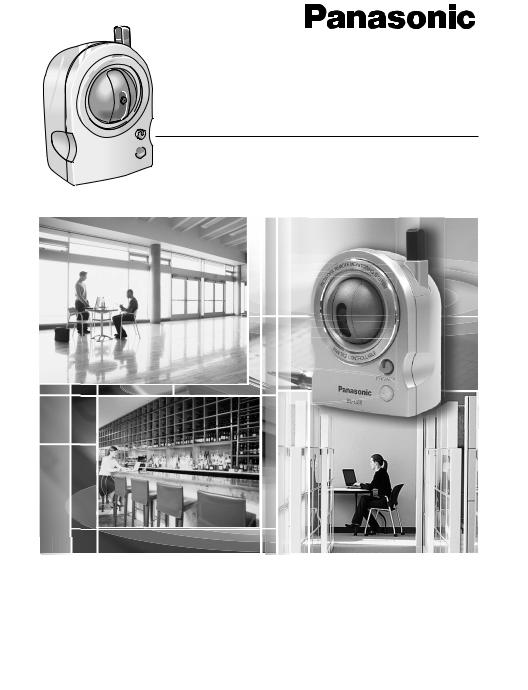
Operating Instructions
Network Camera
Model No. BL-C30
Please read this manual before using and save this manual for future reference.

Operating Instructions
Main Features
Wireless Communication
Network Camera corresponds to the wireless system based on IEEE 802.11b/g. Wireless installation will play an increasing role in flexible mounting. Communication via Ethernet cable is also available. Encryption establishes the security on the wireless network.
Various remote monitoring features
•Pyroelectric infrared sensor*1 detects temperature differences caused by a human body or animals.
•Detection can let camera transfer images by E-mail or FTP*2.
•Color night view mode (auto-adjusted) enables the camera to display images even in 1 lx illuminance*3.
Monitoring from PC or mobile phone
•The camera images can be monitored over the Internet.
•Pan/tilt operation can move the lens horizontally from -50 ° to +50 ° and vertically from -40 ° to +10 °.
Privacy mode
•Privacy mode hides the lens into the unit to protect privacy.
•Pressing the privacy button on the front of the camera switches privacy mode on or off with a single touch.
|
Privacy |
Monitoring |
Purpose |
|
|
|
|
Privacy mode |
On |
Disabled |
Protecting privacy |
|
|
|
|
Monitoring |
Off |
Enabled |
Remote monitoring |
|
|
|
|
*1
*2
*3
The sensor uses pyroelectric effect. Due to the effects of environment temperature, direct sunlight or air conditioner, it may detect the temperature differences by mistake, or the detection range may be shortened.
It may take some time to transfer images depending on the network condition.
1 lx is the brightness about 2.5 m away from auxiliary fluorescent light. Color night view mode slows down the frame rate, and images may blur when viewing a moving object or using the pan/tilt operation.
2

Operating Instructions
Easy installation using UPnPTM (Universal Plug and Play)
When connecting the camera with a UPnPTM enabled router, the camera automatically configures its network settings.
*Some UPnPTM enabled routers cannot configure the camera automatically. In this case, the router needs to be configured manually. Ask the router manufacturer how to configure it. See Panasonic Network Camera support website at
http://panasonic.co.jp/pcc/products/en/netwkcam/ for more information.
Supporting Viewnetcam.com service
Viewnetcam.com service allows you to access the camera over the Internet with your favorite domain name (e.g. bob.viewnetcam.com) instead of a global IP address.
*Viewnetcam.com service is the service for Panasonic Network Camera. See Viewnetcam.com website (http://www.viewnetcam.com) for more information.
Multi-Language Display
Top page, Single Camera and Multi-Camera page can be displayed in English, French, German, Italian, Spanish, Russian, Simplified Chinese or Japanese. If you select English or Japanese, all pages can be changed. But if you select other language, the Setup, Maintenance and Support pages are displayed only in English.
3

Operating Instructions
System Requirements for your PC
Your PC (Personal Computer) and network must meet the following technical specifications for the camera to work properly.
Item |
Description |
|
|
Operating |
Microsoft® Windows® XP, Microsoft® Windows® 2000 |
System |
Microsoft® Windows® Me, Microsoft® Windows® 98SE |
|
|
CPU |
Pentium® III (500 MHz or greater is recommended.) |
|
|
Protocol |
TCP/IP protocol (HTTP, TCP, UDP, IP, DNS, ARP, ICMP) |
|
|
Interface |
10/100 Mbps network interface installed |
|
|
Web Browser |
Internet Explorer 6.0 or later (Not included on the Setup CD- |
|
ROM) |
|
|
Note
See Panasonic Network Camera support website at http://panasonic.co.jp/pcc/products/en/netwkcam/ for the latest information about web browser.
Trademarks
•Adobe, Acrobat and Reader are either registered trademarks or trademarks of Adobe Systems Incorporated in the United States and/or other countries.
•Microsoft, Windows, Hotmail and ActiveX are either registered trademarks or trademarks of Microsoft Corporation in the United States and/or other countries.
•Pentium is a trademark or registered trademark of Intel Corporation or its subsidiaries in the United States and other countries.
•Screen shots reprinted with permission from Microsoft Corporation.
•All other trademarks identified herein are the property of their respective owners.
Abbreviations
•UPnP is the abbreviation for "Universal Plug and Play".
•"Network Camera" is called "Camera" in this Operating Instructions.
4

Operating Instructions
IMPORTANT SAFETY INSTRUCTIONS
When using this unit, basic safety precautions should always be followed to reduce the risk of fire, electric shock, or personal injury.
1.Read and understand all instructions.
2.Keep these instructions.
3.Heed all warnings.
4.Follow all instructions.
5.After taking away the dust on the lens, wipe the lens with a cotton bud.
6.Do not install near any heat sources such as radiators, heat registers, stoves, or other devices (including amplifiers) that produce heat.
7.Protect the AC adaptor cord and AC cord from being walked on or pinched particularly at plugs, convenience receptacles, and the point where they exit from the unit.
8.The AC cord is used as the main disconnect device, ensure that the socketoutlet is located/installed near the equipment and is easily accessible.
9.Do not touch the unit, AC adaptor, AC adaptor cord or AC cord during lightning storms.
10.Unplug the unit when unused for long periods of time.
11.Refer all servicing to qualified service personnel. Servicing is required when the unit has been damaged in any way, such as the AC adaptor cord, AC cord or plug is damaged, the unit does not operate normally, or has been dropped.
12.Prolonged exposure to direct sunlight or halogen light may damage CMOS sensor.
13.The camera is intended for indoor use only. Please check local regulations as outdoor use of the wireless feature is restricted in some countries/areas.
User Name and Password Protection
The use of a unique User Name and secret Password is an important tool that will help limit unauthorized individuals from accessing the camera. If you choose to disable this tool, and choose not to limit access by use of a User Name and Password, this may result in access to the camera by unauthorized individuals. (See page 49)
SAVE THESE INSTRUCTIONS
5

Operating Instructions |
|
|
Table of Contents |
|
|
1 |
Camera Monitoring ....................................................... |
8 |
1.1 |
Accessing the Camera................................................................... |
8 |
1.2 |
Viewing Single Camera page....................................................... |
10 |
1.2.1 Image Auto Centering (Click to Center)................................................... |
14 |
|
1.2.2 Capturing a Still Image ............................................................................ |
15 |
|
1.2.3 |
Using Operation Bar ................................................................................ |
16 |
1.2.4 Setting Home Position/Sensor Position/Preset Button............................. |
18 |
|
1.3 |
Viewing Multi-Camera page......................................................... |
22 |
1.4 |
Viewing Buffered Image page ...................................................... |
24 |
1.4.1 |
Deleting Buffered Images ........................................................................ |
25 |
1.5 |
Viewing Still Images on Your Mobile Phone................................. |
26 |
2 |
Various Camera Features ........................................... |
28 |
2.1 |
Using Camera Features ............................................................... |
28 |
2.2 |
Connecting the Camera to Your Network..................................... |
31 |
2.3 |
Using Wireless LAN ..................................................................... |
36 |
2.4 |
Using UPnP™ (Universal Plug and Play) .................................... |
40 |
2.5 |
Registering with the Viewnetcam.com service ............................ |
41 |
2.6 |
Setting Date and Time ................................................................. |
43 |
2.7 |
Changing Camera Settings.......................................................... |
45 |
2.8Changing Authentication Setting and Administrator User Name
|
and Password .............................................................................. |
49 |
2.9 |
Logging in to the Camera............................................................. |
52 |
2.10 |
Creating, Modifying or Deleting General Users ........................... |
53 |
2.11Changing Initial Settings on the Single Camera page or the Multi-
|
Camera page ............................................................................... |
55 |
2.12 |
Configuring Multiple Cameras...................................................... |
58 |
2.13 |
Buffering or Transferring Images by Timer................................... |
60 |
2.14 |
Buffering or Transferring Images by Sensor................................. |
68 |
2.15 |
Specifying Operation Time........................................................... |
78 |
2.16 |
Changing Indicator Display .......................................................... |
80 |
2.17 |
Enabling Privacy Mode ................................................................ |
81 |
6

|
Operating Instructions |
|
3 |
Camera Maintenance .................................................. |
82 |
3.1 |
Maintenance page ....................................................................... |
82 |
3.1.1 |
Confirming the Status.............................................................................. |
83 |
3.1.2 Confirming the Wireless Status ............................................................... |
83 |
|
3.1.3 |
Restarting the Camera ............................................................................ |
84 |
3.1.4 Updating the Camera Firmware .............................................................. |
85 |
|
3.1.5 |
Creating Configuration File...................................................................... |
88 |
3.1.6 Loading Settings from a Configuration File ............................................. |
89 |
|
3.1.7 Resetting the Camera to Factory Default ................................................ |
90 |
|
3.2 |
Support page ............................................................................... |
91 |
3.2.1 |
Seeing Help page .................................................................................... |
91 |
3.2.2 |
Seeing Wireless Help page ..................................................................... |
92 |
3.2.3 |
Seeing Product Information ..................................................................... |
92 |
3.2.4 |
Seeing Support Information..................................................................... |
92 |
3.3 |
FACTORY DEFAULT RESET Button............................................ |
93 |
3.4 |
Default Setting List ....................................................................... |
94 |
3.5 |
Cleaning..................................................................................... |
102 |
3.5.1 |
Cleaning the Main Unit .......................................................................... |
102 |
3.5.2 |
Cleaning the Lens.................................................................................. |
102 |
3.6 |
Setting an IP Address on Your PC ............................................. |
103 |
3.7 |
Using Setup Program................................................................. |
104 |
3.8 |
Setting Your PC.......................................................................... |
107 |
3.8.1 Setting the Proxy Server Settings on Web Browser ............................. |
107 |
|
3.8.2 |
Setting UPnP™ to Display Camera Shortcut in My Network Places..... |
110 |
3.8.3 |
Setting the Internet Temporary File Setting on Web Browser................ |
110 |
3.9 |
ASCII Character Table ............................................................... |
111 |
3.10 |
File Size and Number of Buffered Images ................................. |
112 |
3.11 |
Specifications............................................................................. |
113 |
Index.................................................................................. |
115 |
|
7

Operating Instructions
1 Camera Monitoring
1.1Accessing the Camera
1.Start up the web browser on your PC.
2.Enter "http://IP Address (or URL):Port Number" on the address bar, and press [Enter] on the keyboard.
E.g. http://192.168.0.253:50000
(or http://XXXXX.viewnetcam.com:50000)
•When port number is 80 (default), you do not need to enter port number. See page 33 for details about port number.
•If the camera image is not displayed, see page 25 of the Installation/ Troubleshooting.
3.The Enter Network Password window is displayed, and enter the user name and password that were set, and click [OK].
Note
When [Permit access from guest users] is set on the Security: Administrator page, the authentication window will not be displayed.
8
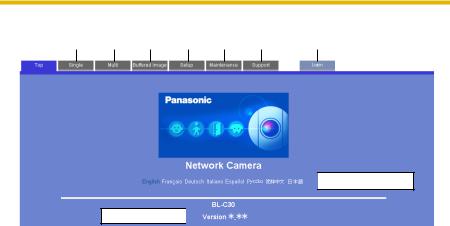
Operating Instructions
4. Click the following tabs to display each page.
A B C D E F
Version Number 

G

 Select a language.
Select a language.
A To Single Camera page (page 10) C To Buffered Image page (page 24) E To Maintenance page (page 82)
G To log in to the camera (page 52)
B To Multi-Camera page (page 22) D To Setup page (page 28)
F To Support page (page 91)
Note
When users other than an administrator are accessing the camera, the [Setup] and [Maintenance] tab will not be displayed. Additionally, When [Do not permit access from guest users] is set on the Security:Administrator page, the [Login] tab will not be displayed.
5. Close the web browser.
9
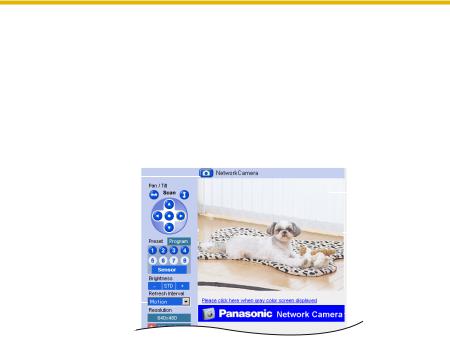
Operating Instructions
1.2Viewing Single Camera page
1.Access the camera (see page 8).
•The Top page is displayed.
2.Click the [Single] tab at the top of the page.
•When the Security Warning window is displayed, click [Yes] (see page11).
•See page 12 for the Security Warning window when using Microsoft Windows XP Service Pack 2.
Capture Image |
|
|
|
|
|
|
|
Click to Center |
|
|
|
|
|
|
|
||
Button |
|
|
|
|
||||
|
|
|
|
|||||
(See page 15) |
|
|
|
|
(See page 14) |
|||
Operation Bar |
|
|
|
|
|
|
|
Camera Image |
|
|
|
|
|
|
|
||
|
||||||||
(See page 16) |
|
|
|
|
|
|||
Refresh |
|
|
|
|
|
|
The banner is |
|
|
||||||||
Interval |
|
|
|
|
displayed. |
|||
|
|
|
|
|||||
(See page 16) |
|
|
|
|
(See page 13) |
|||
3. Close the web browser. |
|
|
|
|
|
|||
Notes |
|
|
|
|
|
|||
•While viewing images under florescent lighting, the image may appear noisy or experience flicker if the incorrect AC power setting was selected. Select the frequency that is used in your area. (see page 45).
•Refresh interval is [Motion] by default. You can change it on the operation bar (see page 16).
•Refresh interval may change depending on the network condition, PC performance and what object you view.
•When displaying video (Motion JPEG), the camera allows up to 20 simultaneous accesses. When trying more than 20 accesses, the 21st user will see a gray screen. (Maximum 20 accesses for a Buffered Image page too.)
•If the video (Motion JPEG) display is limited (see page 55), the video will be changed to refreshing still images.
10
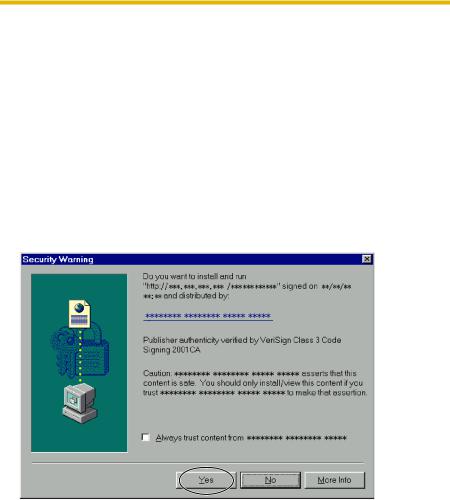
Operating Instructions
•To reduce the data traffic, the video can be automatically changed to refreshing still images (see page 55).
•To display the Single Camera page directly, add it to the [Favorites] on the web browser.
•Refresh interval may slow down depending on the network condition or the number of accessing users.
•When viewing a dark image, Color Night View mode automatically starts. The image will be brighter, but the refresh interval may slow down and image quality may decrease.
•The image may stop refreshing because the wireless communication can be disconnected depending on the environment.
Security Warning window
To view a video (Motion JPEG), ActiveX® Controls must be installed. When trying to display a video for the first time, Security Warning window will be displayed. When using Windows XP or Windows 2000, log in as an administrator to install it.
If you cannot install ActiveX Controls or you cannot see the video in the Internet Explorer
•Click [Tools] [Internet Options]
[Internet Options] [Security] tab and click [Custom level] on the web browser.
[Security] tab and click [Custom level] on the web browser.
(1)Check "Prompt" in "Download signed ActiveX Controls".
(2)Check "Enable" in "Run ActiveX Controls and plug-ins".
•ActiveX Controls can be installed from the file on the Setup CD-ROM.
(1)Restart the PC.
(2)Confirm that Internet Explorer is closed.
(3)Double-click "ocx\ActiveXInst.exe" on the Setup CD-ROM.
11
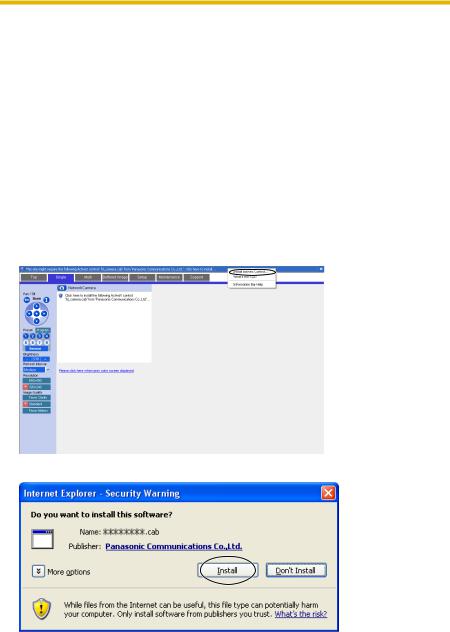
Operating Instructions
Notes
•When the IP address was changed for the camera, enter it on the address bar.
•Video may not be displayed quickly. Wait for a while.
•If you use a proxy server, set the web browser not to access the proxy server (see page 107).
•In some corporate network environments a firewall may be used for security purposes. It is possible that this may prevent motion video from being displayed. In this situation we suggest:
•Contact your network administrator.
•Try using regularly refreshed images.
Security Warning window on Microsoft Windows XP Service Pack 2
To view a video (Motion JPEG), ActiveX Controls must be installed. Follow the steps shown below to install ActiveX Controls.
1.Click the warning displayed above the tabs, and click [Install ActiveX Control...].
2. Click [Install].
12

Operating Instructions
The Banner
When the camera accesses the Internet, the banner displays product information about cameras or announcements about the latest firmware, etc. from Panasonic. Whether or not to display the banner can be set at Banner Display (see page 55).
Notes
•The banner is displayed when [Yes] is checked for Allow Access from the Internet on the Automatic Setup page, or when [Enable] is checked for Auto Port Forwarding on the UPnP page for the Connection Mode of Static or DHCP.
•Even if [Yes] is checked for Allow Access from the Internet on the Automatic Setup page, or [Enable] is checked for Auto Port Forwarding on the UPnP page for the Connection Mode of Static or DHCP, when the camera is not connected
to the Internet,  is displayed.
is displayed.
13
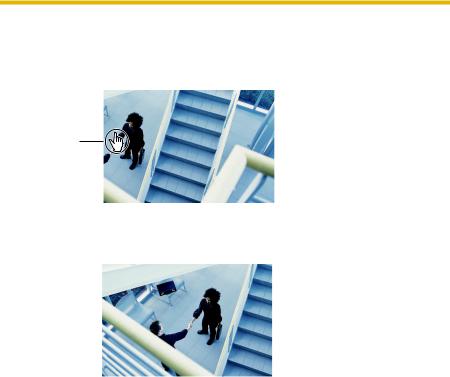
Operating Instructions
1.2.1Image Auto Centering (Click to Center)
When you click a certain point on the camera image, the point is centered on the image.
1. Move the cursor to the desired point.
Cursor
2.Click it.
•The clicked point is centered.
•See page 17 for the pan/tilt operation.
Notes
•When End Display appears on the operation bar, Click to Center does not work beyond the pan/tilt end (see page 16).
•The clicked position may slightly miss the center depending on the lens direction.
•If a user is restricted to level 1 or 2 on the General User page (see page 53), Click to Center does not work.
14
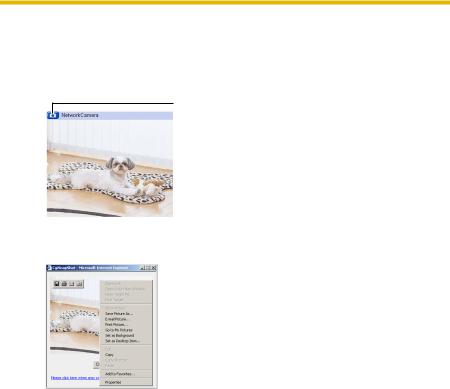
Operating Instructions
1.2.2Capturing a Still Image
A still image can be saved on your PC.
1.Operate pan/tilt and select a resolution to display an image.
2.Click the capture image button.
Capture Image Button
• The camera image opens in another window.
3.Right-click the image, and select [Save Picture As...].
•Save as dialog box is displayed.
4.Specify a folder, and click [Save].
•Camera image is saved in the folder.
5.Click [Close].
15
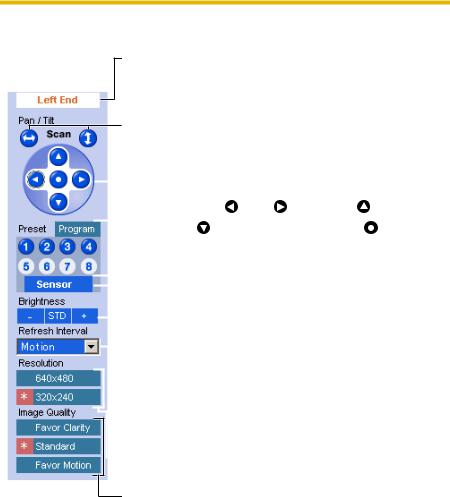
Operating Instructions
1.2.3Using Operation Bar
End Display
and Preset
Display:
Pan/Tilt
Scan:
When the pan/tilt has reached the end (Left End, Right End, Up End and Down End), End Display appears. When clicking a preset button, the preset name appears.
Moves the lens throughout the horizontal ( )
)
or vertical ( ) range, and returns to the original position.
) range, and returns to the original position.
|
|
|
|
|
|
|
|
|
|
Pan/Tilt/ |
Controls lens direction. |
|
|
|
|
|
|
|
|
|
|
|
|
|
|||
|
|
|
|
|
|
|
|
|
Home |
Pan ( : Left, : Right), Tilt ( |
: Up, |
||
|
|
|
|
|
|
|
|
|
Position: |
||||
|
|
|
|
|
|
|
|
|
: Down) and Home Position ( |
: Center) |
|||
|
|
|
|
|
|
|
|
|
|
|
|
||
|
|
|
|
|
|
|
|
|
Preset |
Applies the camera direction to a preset |
|||
|
|
|
|
|
|
|
|
|
Button: |
position. You can preset 8 positions (see page |
|||
|
|
|
|
|
|
|
|
|
|
Sensor |
18—page 21). |
|
|
|
|
|
|
|
|
|
|
|
|
When the sensor detects a temperature |
|||
|
|
|
|
|
|
|
|
|
|
||||
|
|
|
|
|
|
|
|
|
Position: |
difference, the camera can be set up to turn to |
|||
|
|
|
|
|
|
|
|||||||
|
|
|
|
|
|
|
|
|
|
|
|
this position. Only an administrator can operate |
|
|
|
|
|
|
|
|
|
|
Brightness: |
it (see page 18). |
|
||
|
|
|
|
|
|
|
|
|
|
||||
|
|
|
|
|
|
|
|
|
Changes brightness in nine steps including |
||||
|
|
|
|
|
|
|
|
|
|||||
|
|
|
|
|
|
|
|
|
|
|
|
[STD] (Standard). Clicking [-] or [+] changes the |
|
|
|
|
|
|
|
|
|
|
|
|
|
image brightness. |
|
|
|
|
|
|
|
|
|
|
|
|
Refresh |
Sets a refresh interval. (Motion—60-second |
|
|
|
|
|
|
|
|
|
|
|
||||
|
|
|
|
|
|
|
|
|
Interval: |
interval) |
|
||
|
|
|
|
|
|
|
|
|
|
|
Resolution: |
Selects [640 x 480] or [320 x 240] (default) |
|
|
|
|
|
|
|
|
|
|
|
|
|||
|
|
|
|
|
|
|
|
|
|
|
|
pixels. |
|
Image Selects the image quality.
Quality: • [Favor Clarity] optimizes the image for good clarity.
•[Standard] keeps the standard quality. (default)
•[Favor Motion] optimizes the image for motion display.
Note
When the camera image is not displayed correctly, click [Refresh] at the tool bar on the web browser. The image will be refreshed.
16
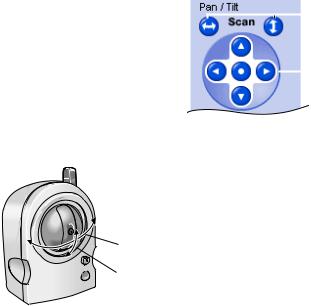
|
|
|
Operating Instructions |
|
Pan/Tilt Operation |
|
|
||
Pan/tilt scan buttons automatically move the |
|
Pan/Tilt |
||
lens horizontally from -50 ° to +50 ° and |
|
|
|
|
|
|
|
||
vertically from -40 ° to +10 ° and return the |
|
Scan |
||
lens to the original position. Each pan/tilt |
|
|
||
arrow moves the lens Up, Down, Right or Left, |
|
Pan/Tilt |
||
and the home position button moves it to the |
|
|||
|
||||
home position. |
|
|
||
Pan/Tilt Range
Pan: -50 ˚ to +50 ˚
Tilt: -40 ˚ to +10 ˚
Note
Do not apply pressure to the pan/tilt portion of the camera. Any forced movement can damage the internal mechanism.
17
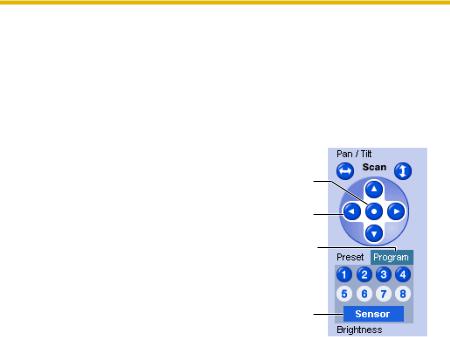
Operating Instructions
1.2.4Setting Home Position/Sensor Position/Preset Button
Registering Home Position/Sensor Position
A home position or sensor position can be registered. When restarted, the camera takes a home position. If the Lens Position When Triggered setting is set (see page 69), the camera takes a sensor position after the pyroelectric infrared sensor detects temperature differences.
1.Click [Program].
•[Program] switches to [Cancel]. Click [Cancel] to quit without saving changes.
2.Pan and tilt the camera to a desired position.
3.Click the home position button or the sensor position button.
4.Click [Save] to register, or click [Back] and [Cancel] to cancel.
•If "Success!" is displayed, click [Back].
Home
Position
Pan/Tilt
Program
Sensor
Position 
18

Operating Instructions
Registering a Preset Button
8 preset buttons can be registered. Preset buttons (1—4 ) are registered 1: Upper Left, 2: Upper Right, 3: Lower Left and 4: Lower Right. These buttons can be changed (see page 21).
•Registered buttons are shown in blue.
•Unregistered buttons are shown in white.
1.Click [Program].
•[Program] switches to [Cancel]. Click [Cancel] to quit without saving changes.
2.Pan and tilt the camera to a desired position.
3.Click a preset button (1—8) to register.
E.g.:
Setting "Middle" for the preset 5.
4.Enter the preset name.
•Maximum 15 characters.
•Enter ASCII characters (see page 111) or characters in each language. But [Space], ["], ['], [&], [<] and [>] are not available.
5.Click [Save] to register, or click [Back] and [Cancel] to cancel.
•If "Success!" is displayed, click [Back].
Notes
•When registering preset buttons, the camera also saves brightness and white balance settings.
•Only an administrator can register preset buttons.
Pan/Tilt
Preset
Preset number
Setting a name
The button turns blue.
19

Operating Instructions
Viewing the Image
1.Click the home position, sensor position or registered preset button.
•The camera takes each position, and the image is displayed.
Home
Position
Pan/Tilt
Putting the cursor displays the preset
name.

 UpperLeft
UpperLeft
Sensor
Position 
20
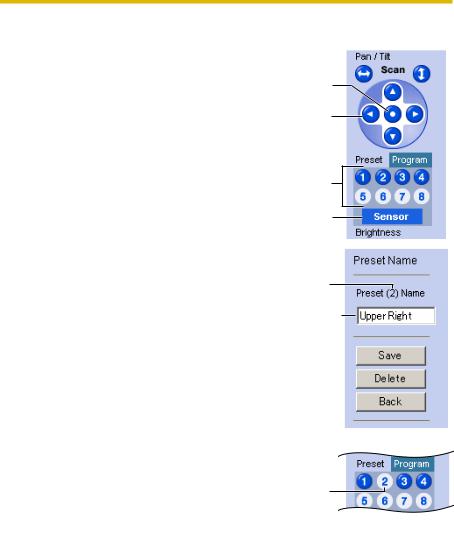
Operating Instructions
Changing or Deleting the Settings
1.Click [Program].
•[Program] switches to [Cancel]. Click [Cancel] to quit without saving changes.
2.Pan and tilt the camera to a desired position.
•When deleting, this step is not necessary.
3.Click the home position, sensor position or a preset button (1—8).
4.Click [Save] after setting the preset name or click [Delete].
•If you quit to change or delete settings, click [Back], and then [Cancel].
•If "Success!" is displayed, click [Back].
Note
The home position or the sensor position cannot be deleted, and these position names cannot be changed either.
Home
Position
Pan/Tilt
Preset
Sensor
Position 
Preset number
Changing the name
The deleted button turns white.
21

Operating Instructions
1.3Viewing Multi-Camera page
To view multiple cameras on the Multi-Camera page, you need to configure each camera on the Multi-Camera Setup page (see page 58).
1.Access the camera (see page 8).
• The Top page is displayed.
2.Click the [Multi] tab at the top of the page.
•Multi-Camera page can display up to 12 camera images.
Capture Image Button (See page 15)
Switches cameras to display.
Selects [320 x 240] (default) or [160 x 120] pixels resolution.
Selects a refresh interval (Motion—60-second interval). If you select [All] at the View Type, video (Motion JPEG) cannot be displayed.
When clicking the camera name, the Single Camera page is displayed on another window.
3. Close the web browser.
22

Operating Instructions
Notes
•When selecting [All] at the View Type, all images are displayed in 160 x 120 pixels resolution.
•640 x 480 pixels image cannot be displayed on the Multi-Camera page.
•When viewing video (Motion JPEG), we recommend using an Ethernet switching hub instead of the repeater hub to prevent degradation in video display.
•Due to the network congestion or the number of accesses, the refresh interval may slow down.
•When the refresh interval is slow, restrict the bandwidth on the Network page (see page 35). The refresh interval may be improved.
•If the video (Motion JPEG) display is limited (see page 55), the video will be changed to refreshing still images.
•To reduce the data traffic, the video (Motion JPEG) can be automatically changed to refreshing still images (see page 55).
•When viewing 4 cameras on the Multi-Camera page, you may need 3 to 4 Mbps bandwidth. If the bandwidth is not enough, the refresh interval may slow down.
When the image is not displayed on the Multi-Camera page
•Confirm that the Internet IP address isspecified for each camera and that each camera is connected to the Internet. For Internet access, local IP addresses (192.168.xxx.xxx) cannot be used.
•Confirm the settings on the Multi-Camera Setup page (see page 58).
•Confirm that the web browser is not accessing the proxy server (see page 107).
How to save a still image to your PC
On the Single Camera or Multi-Camera page
•A still image can be saved using the capture image button (see page 15).
On the Buffered Image page
•A still image can be saved on the Buffered Image page, if you are not playing images on it. Put the cursor on the image, and right-click it. Then select [Save Picture As...].
When setting [Do not permit unregistered users] on the Security: Administrator page
•An authentication window is displayed in camera access. Enter the administrator's or the general user's user name and password.
•When you view the images on the Multi-Camera page, all authentication windows of the configured cameras are displayed. Enter the administrator's or the general user's user name and password registered for each camera.
23

Operating Instructions
1.4Viewing Buffered Image page
To buffer the images on the internal memory, you need to set up image transfer settings (see page 60 or page 68). You can view buffered images on this Buffered Image page.
1.Access the camera (see page 8).
• The Top page is displayed.
2.Click the [Buffered Image] tab at the top of the page.
3. Click the trigger number.
The trigger number is displayed (see page 60 or page 68).
The trigger is displayed (see page 60 or page 68).
24
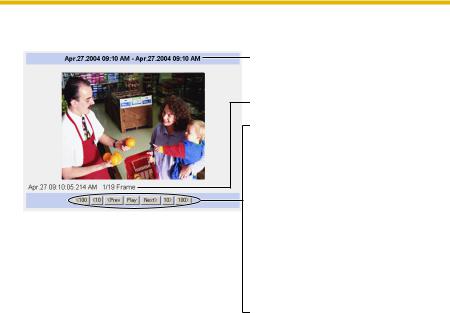
Operating Instructions
4. Display images clicking buttons below.
Date and time of the day when the images were buffered are displayed.
Date, time and frame number are displayed.
[Play]:
The buffered images are displayed continuously.
[<Prev] or [Next>]:
The previous or next image is displayed.
[<10] or [10>]:
The 10th image before or after the current image is displayed.
[<100] or [100>]:
The 100th image before or after the current image is displayed.
Notes
•Date, Time and frame number are not displayed in play mode.
•Maximum number of buffered images change depending on resolution, image quality and what object the camera buffers. At the 320 x 240 pixels resolution and the standard quality, the camera buffers about 250 frames (see page 112). (If 3 trigger settings are enabled, the internal memory capacity is divided into 3 sections. In this case, each trigger can buffer about 80 frames.)
1.4.1Deleting Buffered Images
If you intend to delete images for each transfer condition, click [Delete Buffered Images] on the Image Buffer/Transfer page (see page 60 or page 68).
Notes
•When you change settings (except for Enable/Disable settings) on the Image Buffer/Transfer page, the buffered images only for that trigger will be deleted.
•The following operations also delete all buffered images.
•Turning off the camera.
•Saving the Date and Time page.
•Restarting, updating firmware or resetting the camera to factory default.
•Changing the Enable/Disable settings of Image Buffer/Transfer (see page 60 or page 68).
25
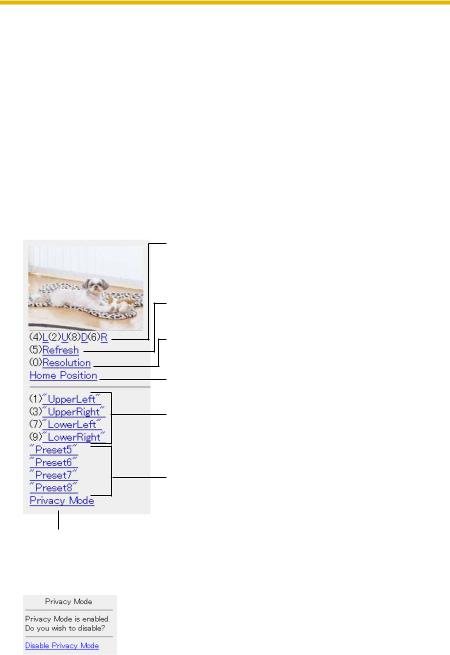
Operating Instructions
1.5Viewing Still Images on Your Mobile Phone
You can view still images over the Internet from a compatible mobile phone. Enter "http://IP address (or URL):Port Number/mobile" on a mobile phone and press [OK].
•When the port number is set to 80 (default), it is not required.
E.g. http://XXX.XXX.XXX.XXX:50000/mobile (or XXXXX.viewnetcam.com:50000/mobile)
•The Internet access to the camera must be allowed for mobile phone access.
•When an authentication window is displayed, enter the administrator's or the general user's user name and password.
•A still image is displayed. (Video [Motion JPEG] cannot be displayed.)
Pressing 2, 4, 6 or 8 on the mobile phones allows you to pan or tilt the camera in four directions: Left, Up, Down or Right.
Pressing 5 will refresh the image.
160 x 120 resolution is displayed at the first access. Pressing 0 switches the resolution to 320 x 240.
Executing [Home Position] moves the lens to the home position.
Pressing 1, 3, 7 or 9 on the keypad allows you to use the first four registered preset buttons.
Registered presets 5—8 are available by activating the link on the mobile phone page.
If you execute [Privacy Mode] here, the camera switches to privacy mode. To disable it, access the camera again and execute [Disable Privacy Mode] (see page 81).
26

Operating Instructions
Notes
•If the image is not displayed properly, try the following 2 URLs.
1.http:// IP address(or URL):Port Number/mobileh for HTML. (or XXXXX.viewnetcam.com:50000/mobileh)
2.http:// IP address(or URL):Port Number/mobilex for XHTML. (or XXXXX.viewnetcam.com:50000/mobilex)
•Only an administrator can control privacy mode.
•In privacy mode, sensor and timer image buffer/transfer features also are stopped.
•When executing [Privacy Mode] while setting [Allowing unregistered users] on the Security: Administrator page (see page 49), an authentication window is displayed. Log in to the camera as an administrator.
•If the users are restricted to level 1 or 2 on the General User page (see page 53), the users do not see some kinds of buttons.
•When pan/tilt reaches the end, the keypad number and character disappear. E.g.: The pan reaches the left end.
 "(4)L" disappears.
"(4)L" disappears. 
•Some mobile phones are not compatible with Panasonic Network Cameras. Some phones may allow viewing only on port 80, and some may not support password authentication. See the Panasonic Network Camera support website at http://panasonic.co.jp/pcc/products/en/netwkcam/ for a mobile phone model list, and the compatibility level which has been verified with the Panasonic Network Camera.
•Some mobile phones display images not at the specified resolution but at a decreased size.
Stopping E-mail Transfer by the Mobile Phone Operation
Executing privacy mode on a mobile phone operation can stop E-mail transfer.
1.Access the camera from a mobile phone (see page 26) and log in to the camera as an administrator.
2.Execute [Privacy Mode] (see page 26).
•The camera switches to privacy mode and stops E-mail transfer (Image Buffer/Transfer).
27

Operating Instructions
2 Various Camera Features
2.1Using Camera Features
1.Access the camera (see page 8).
• The Top page is displayed.
Notes
•When [Permit access from guest users] is set on the Security: Administrator page, click [Login] tab and log in as an administrator.
•When users other than an administrator are accessing the camera, the [Setup] and [Maintenance] tabs are not displayed.
2.Click [Setup] tab at the top of the page.
(1)
(2)
(3)
(4)
(5)
(6)
(7)
(8)
(9)
(10)
(11)
(12)
(13)
(14)
28

|
|
Operating Instructions |
|
|
|
|
|
Basic |
|
|
|
(1) |
Network |
Configures the network settings such as connection mode |
|
|
|
to connect the camera to the network (see page 31). |
|
(2) |
Wireless |
Configures wireless network (see page 36). |
|
(3) |
UPnP |
Enables automatic port forwarding or shortcut to the |
|
|
|
camera (see page 40). |
|
(4)Viewnetcam. Registers with the Viewnetcam.com service (see page 41). com
(5)Date and Time Sets the date and time, automatic time adjustment and
adjust clock for daylight saving time settings (see page 43).
(6) Camera Sets camera name, white balance, AC power source frequency and pan/tilt range (see page 45).
Account |
|
|
(7) |
Administrator*1 |
Sets authentication setting and administrator security (user |
|
|
name and password) (see page 49). |
(8) |
General User*1 |
Sets general user security (user name and password) and |
|
|
general user's feature restriction (see page 53). |
Advanced
(9)Image Display Sets resolution, image quality and refresh interval of Single
Camera and Multi-Camera page, Limit Continuous Motion
JPEG*1 language and banner (see page 55).
(10) Multi-Camera*1 Sets the camera IP address or host name, camera name on the Multi-Camera page (maximum 12 cameras) (see page 58).
(11)Buffer/Transfer Sets image buffer or transfer by timer or sensor. (See page
60 or page 68).
(12)Operation Sets time period to display camera images (see page 78).
Time
*1 If you change [Administrator], [General User], [Limit Continuous Motion JPEG] or [MultiCamera Setup page] settings, changes will not be applied to the video (Motion JPEG) viewers. Restart the camera to make changes applied to all video viewers.
29

Operating Instructions
(13) Indicator |
Sets indicator display (see page 80). |
Control |
|
(14)Privacy Mode Enables privacy mode (see page 81).
30
